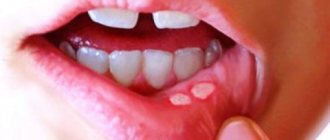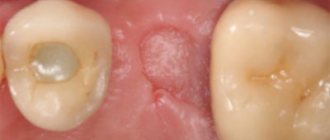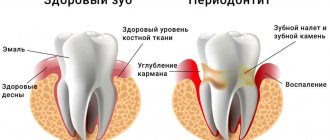What is stomatitis
Stomatitis (mucositis) is a disease that is accompanied by damage to soft tissues in the oral cavity.
It can be either an independent disease or a complication of various pathological processes, for example, measles, influenza, scarlet fever, etc. Until recently, stomatitis was considered a childhood disease. Today it is becoming more common in adults too. This trend raises questions about whether stomatitis is transmitted and, if so, how to protect yourself and your child. It all depends on the form of manifestation of the disease
Is it possible to kiss with stomatitis?
- Is it possible to kiss with stomatitis?
- How to treat stomatitis in an adult
- What diseases are transmitted through a kiss?
Can stomatitis be transmitted by kissing?
Stomatitis is diverse in origin and symptoms. Oddly enough, despite the fact that the disease has been thoroughly studied, experts still do not know exactly the mechanism of its occurrence. The most common version is that stomatitis occurs as a response of the human immune system to unfamiliar irritant substances found in the oral cavity.
As a result of the “attack” of lymphocytes of the immune system on the molecules of these substances, numerous small ulcers arise - the main symptom of stomatitis.
Such substances can be pathogenic microorganisms transmitted by airborne droplets, for example, the herpes virus or staphylococci. In this case, if a person with stomatitis wants to kiss his partner, he will almost certainly “give” him these pathogenic viruses or bacteria. Therefore, it is better not to take risks and refrain from kissing until complete recovery. Never kiss young children when they are sick, because their immune system cannot resist some viruses and bacteria that can be passed on to them.
Stomatitis can also be caused by fungi that have entered the oral cavity. In this case, kissing is also undesirable, because you can transmit these fungi to your partner.
If stomatitis is herpetic, it can even be transmitted through dishes. Therefore, during illness, use personal cutlery and rinse it with boiling water. After recovery, be sure to change your toothbrush.
Why you shouldn't kiss, even if stomatitis is not contagious
There are a number of cases when kissing with stomatitis cannot lead to infection of the partner. For example, if this disease is caused by problems in the gastrointestinal tract or arose as a result of poor oral hygiene, as well as insufficiently accurate selection of dentures. But even then, kissing is still undesirable.
The thing is that due to disturbances in the microflora in the oral cavity and inflammatory processes, stomatitis is often accompanied by the appearance of bad breath. Therefore, when you kiss, you can give your partner not pleasure, but very uncomfortable sensations. It’s better to get cured first, and then kiss your loved one for good health. Stomatitis often goes away within 10 days if you maintain good oral hygiene, take medications, or use medicated ointments.
Symptoms of stomatitis
Stomatitis can be recognized by the following signs:
- ulcers, wounds, erosions and rashes on tissues;
- red color of the mucous membrane;
- plaque on the tongue, inner surface of the cheeks, palate;
- unpleasant taste;
- swelling of tissues;
- heavy salivation;
- bad breath;
- itching and burning – in some cases;
- discomfort and pain;
- bleeding gums – occasionally;
- increased body temperature;
- lymphadenitis.
Symptoms in children are always more pronounced. The child often feels severe pain. Adults tolerate the disease easily. Its symptoms usually do not cause severe discomfort.
When the first symptoms appear, you should immediately consult a doctor to protect yourself and, possibly, others.
Is stomatitis transmitted through kissing?
Summary: [show]
There are different forms of the disease, each with its own mode of transmission. The causative agent of the disease is transmitted through contaminated objects or by airborne droplets from person to person. Even completely healthy people can get stomatitis if they are in prolonged contact with someone who is sick. This infection is quite contagious and even with an ordinary kiss you can catch it.
Is it allowed to kiss with stomatitis?
The nature and manifestations of the pathology are diverse, and, despite the fact that the disease has been sufficiently well studied, experts cannot accurately determine the mechanism of its formation. According to one version, the disease begins due to the response of the immune system to unknown irritants that have penetrated the oral cavity.
Various microorganisms moving through the air (for example, herpes virus or staphylococcus) can act as such irritants. In this case, when kissing a person who has stomatitis, the partner is almost guaranteed to receive pathogenic viruses or bacteria. To prevent unnecessary risk, it is better not to kiss until you have fully recovered.
During the development of the disease, it is absolutely forbidden to kiss young children, since their immune system has not yet developed ways to fight certain infectious agents. Stomatitis can also be caused by fungi that have settled in the oral cavity, so in such cases it is also worth temporarily limiting kissing so as not to transmit pathogens to your partner.
What to do if stomatitis is not contagious
In some cases, the disease is provoked not by infectious agents, but by other factors. These may be pathologies of the gastrointestinal system, poor oral hygiene, or incorrectly selected dentures. In such cases, you should also not kiss, since due to an imbalance of microflora in the oral cavity and the development of inflammatory processes during illness, bad breath is often observed. The partner in such a situation will receive only unpleasant sensations from the kiss, and not positive emotions.
If hygiene measures are observed and appropriate medications are taken, stomatitis is cured in 10 days, after which you can safely kiss your loved ones.
Types of disease
Stomatitis has different forms, depending on which the doctor determines whether it is contagious or not, and also prescribes appropriate treatment.
Allergic stomatitis
This is a common form of the disease that is difficult to treat. From the name it is clear that the cause of its development is an allergy, but it is necessary to find out what exactly it is. These could be medications, food, materials used for prosthetics. The disease is accompanied by the appearance of ulcers, which provoke pain.
Viral stomatitis
The most common type of viral stomatitis is herpetic stomatitis, the causative agent of which is the herpes virus. There are other forms that are provoked by adenovirus, enterovirus, etc. They are often found in children under 5–6 years of age, but are also common among older age groups. A feature of viral stomatitis is its erosive spread, when one ulcer appears next to another. Herpes mucositis may cause complications such as fever, nausea, vomiting and diarrhea.
This form of the disease is transmitted to others by contact and airborne droplets. If it is diagnosed, for example, in someone in kindergarten, then quarantine must be introduced. Infection occurs through dishes and toys, so the disease can quickly spread from child to child.
The virus spreads from nursing mothers to children if hygiene rules are violated. Adults become infected even through handshakes. Sneezing also causes the disease to develop.
Aphthous stomatitis
This form is common among adults. It develops against the background of a weakening of the body’s immune forces, so aphthous stomatitis is a common occurrence in spring and autumn. With this type of disease, characteristic aphthae appear - small ulcers. They can be single or group. Aphthous mucositis is not spread from person to person.
Fungal stomatitis
The disease manifests itself in children and adults, mainly in infants and women. It is provoked by fungi of the genus Candida, which are activated in the oral cavity when the immune system is weakened. The cause of fungal stomatitis can be long-term use of antibiotics. In addition to ulcers, its characteristic feature is a cheesy coating on the tongue, palate and inner surface of the cheeks.
Bacterial stomatitis
This type of disease is diagnosed when the oral cavity is affected by microorganisms, most often streptococci, staphylococci. The manifestation of bacterial stomatitis is provoked by tuberculosis, as well as sexually transmitted diseases, for example, gonorrhea, syphilis. More often, children whose immunity is not strong enough suffer from it. But everyone must be careful. The disease is transmitted from children to adults through dishes, toys, and damage to the mucous membrane.
This form is characterized by swelling in the oral cavity, redness of the mucous membrane and hardening of the palate, as well as an unpleasant odor, ulceration and cracks. Symptoms of intoxication may appear: vomiting, weakness, rapid pulse.
Other forms of stomatitis
In addition to the above types of disease, the following can also be distinguished:
- chemical stomatitis - occurs as a result of burns to the oral cavity with alkaline substances or acid;
- traumatic - ulcers are formed as a result of impact and disruption of tissue integrity;
- radiation – develops as a result of radiation.
Such forms are non-contagious and therefore do not pose a danger to other people.
How is stomatitis transmitted, is it contagious or not?
Changes in the mucous membrane of the oral cavity in a person, whether ulcers or scratches, cause discomfort and interfere with normal life. When such changes are detected, many immediately believe that it is stomatitis. How to distinguish characteristic rashes from other diseases of an inflammatory nature and what it is, whether it poses a threat to others and the victim’s body as a whole are questions that plague those who are faced with this problem.
What is stomatitis: causes and symptoms
Stomatitis is an inflammatory disease that affects the oral mucosa, which is caused by various infectious and non-infectious factors.
Over time, the usual form of the sore can become complicated, when ulcers and hemorrhages appear at the site of inflammation, causing even greater discomfort for the patient at the time of eating. Against this background, body temperature rises, malaise and drowsiness appear.
Based on the etiological factor, you can understand whether stomatitis is contagious or not for surrounding people.
For non-infectious stomatitis, the trigger is often a weakened immune system. Young children often face this problem, since their immunity is still defective.
The most common causes of the disease are:
- oral care;
- cleaning your mouth with someone else's personal hygiene devices;
- reduced immune system due to concomitant diseases;
- infectious nature;
- allergic reactions to the active components of toothpastes or rinses;
- mechanical damage from a toothbrush with rough bristles or dental sticks.
Types of stomatitis and routes of infection
In order to figure out whether the patient is contagious to others or not, it is important to distinguish between the types of stomatitis.
- Infectious etiology:
- viruses;
- bacteria;
- fungal flora.
- Non-infectious nature:
- traumatic;
- aphthous.
An examination of the patient’s oral cavity and a survey will help you understand which type is present in the patient. It is important to know with whom this person communicated the day before and what complaints he had. Knowledge of the distinctive features of each listed species will be able to correctly guide the doctor as to whether there is a risk of becoming infectious or not.
Is stomatitis in adults contagious or not?
Due to the fact that there are many etiological factors, not all of them are dangerous. Infectious stomatitis is contagious in adults and children, non-infectious diseases (traumatic and aphthous) are not contagious.
Viral lesions of the mouth, regardless of the pathogen, are transmitted to others through any contact (domestic, hematogenous, etc.) with an infectious person. This species is contagious.
In children, the main cause of stomatitis is the proliferation of bacterial pathogenic flora, due to their curiosity and mania for putting everything in their mouth.
Is stomatitis transmitted through a kiss or not?
Some types of stomatitis can be transmitted through saliva (kissing). Any pimple of infectious etiology poses a certain threat to the health of the person in contact with the patient.
How can stomatitis be transmitted?
- airborne droplets (at the time of communication);
- hematogenous route (through blood);
- contact or household route (unwashed hands, use of shared utensils or other personal hygiene devices);
- from mother to child (breastfeeding);
- interaction with other biological fluids (saliva during kissing, the entry of amniotic fluid into the baby’s oral cavity, sexual intercourse).
Since stomatitis of infectious etiology is contagious for any person, you should familiarize yourself with each type in detail and learn to distinguish them from non-infectious inflammation.
Viral
The viral form is one of the most contagious among other types. This disease is characterized by the presence of a specific pathogen that causes this condition. In this regard, the following are highlighted:
- herpetic;
- enterovirus;
- influenza and parainfluenza;
- associated with the causative agent of chickenpox;
- adenoviral.
Depending on the incubation period, which lasts 5–14 days, characteristic symptomatic manifestations appear. During this period of time, the patient is contagious to others, but danger threatens when symptoms appear (presence of ulcers with blisters, soreness, elevated body temperature). More often, stomatitis is transmitted by airborne droplets.
When kissing an infected person, there is an increased risk of stomatitis (contact with infectious biological fluid).
It is important not to confuse the clinical manifestations of infectious stomatitis with signs of tonsillitis (during examination, the mucous membrane of the tonsils is affected).
Bacterial
Bacterial stomatitis - manifests itself in children. This is due to a weak immune system and frequent injuries to the oral mucosa. Damaged tissue is an entry point for bacteria. In the area of implantation, local inflammation, swelling, and pain appear. There is an unpleasant odor from the mouth. When foreign microorganisms enter the blood, intoxication syndrome increases (body temperature rises, malaise, drowsiness, loss of appetite).
This species is as contagious as a viral one, and is most often transmitted through the air and through household contact.
Fungal
Fungal stomatitis in the mouth is contagious for healthy people if they use shared, poorly washed dishes, etc. The household route of transmission predominates here.
A characteristic feature of this type of stomatitis will be a white coating over the inflamed area of the mucous membrane. Intoxication syndrome is unlikely, since the fungal infection occurs only in the mucous (mucosal) layer.
Aphthous
Aphthous stomatitis is an inflammation of the oral mucosa that is not associated with an infectious nature. It occurs most often against a background of stress or as a manifestation of a local allergic reaction.
Upon examination, there will be a white or yellow sore - aphtha, which brings discomfort while eating. Don't worry about your loved ones - it's not contagious!
Traumatic prosthetic stomatitis
Sores or ulcers often appear in the oral cavity due to damage from foreign bodies (solid food, dentures, toothbrush with coarse bristles, etc.). Since the dentures are not tightly fixed, their movement causes irritation and injury to the mucous membrane. At the site of unstable fixation, the tissue becomes inflamed.
Despite the safe form of the disease in this category of people, the question arises whether it is possible to become infected with traumatic stomatitis in general or not.
With ordinary prosthetic stomatitis, there is no danger to others, but if complications are detected after infection, the patient becomes infected.
Preventive measures. How to protect yourself when communicating with a sick person
In order to prevent the development of stomatitis and not become contagious, you need to learn a few points:
- oral hygiene (using your own toothbrush);
- thoroughly wash shared utensils (it is advisable to have your own cup, plate, fork, etc.);
- interrupt contact with an infectious person (wearing a medical mask, keeping a distance at the time of conversation);
- the use of vitamin complexes with reduced immunity;
- proper nutrition;
- visit the dentist once a year.
If signs of illness are detected and in order to avoid possible infection of relatives, you should immediately seek medical help from a dentist.
As a result, it should be remembered that stomatitis that has an infectious etiology is contagious. It is not difficult to distinguish this species from a non-infectious one. Knowledge of the clinical picture of the disease can preserve not only the health of the infected person, but also the health of the people around him.
Ways of transmission of stomatitis
Let's summarize. Viral, bacterial and herpetic forms of stomatitis are contagious. Knowing how the disease is transmitted, you can protect yourself and your loved ones. Ways of transmission of infection:
- airborne - sneezing, coughing;
- household items - common dishes, linen, personal items;
- toys, raw pacifiers, rattles;
- dirty hands;
- unwashed food;
- biological fluids - through saliva, blood, breast milk;
- Pets can carry the virus.
It is possible to catch the infection anywhere – from the street to your own home. You can get infected from both a child and an adult.
How is it transmitted?
Most forms of the disease have similar initial manifestations. These include:
- Deterioration in health .
- The appearance of red spots on the mucous membranes.
- The appearance of watery blisters.
Ulcerative stomatitis
Ulcerative stomatitis is an inflammation of the membranes of the mouth that occurs against the background of decay of the mucous membrane.
Blisters filled with clear liquid are located on:
- Inner surface of cheeks.
- Language.
- Sometimes - gums.
They are painful and make talking and eating difficult. Later, ulcers form in their place.
All types of stomatitis of viral origin are classified as infectious diseases. The main routes of transmission are blood flow, lymph flow, contact, airborne droplets.
Each type of disease is characterized by a similar clinical picture: redness of the mucous membrane, blisters, deterioration of health, fever.
This is the picture of classic viral stomatitis in an adult. The child's temperature rises and lethargy is observed. He complains of a burning sensation in his mouth. Possible sneezing and runny nose.
Such symptoms require consulting a doctor. If a diagnosis of viral stomatitis is made, it will be necessary to find out which virus caused the disease. In order of frequency of occurrence these are:
- Herpes.
- Flu.
- Adenovirus.
- Smallpox.
How long does it take for stomatitis to go away?
Stomatitis is a disease that affects the mucous membrane of the oral cavity.
All types of viral stomatitis are contagious. Routes of infection:
- Airborne.
- With blood.
- With lymph flow.
- Contact.
Viral stomatitis is easily transmitted through a kiss. Any minor wound opens the way for the virus to enter the circulatory system. Further, the situation will develop depending on how well formed the immune response of the person who received the virus is.
You should not contact a person with stomatitis.
Together with saliva, herpesvirus, primary syphilis, and Behçet's disease can be transmitted. If for some reason contact cannot be avoided, it is recommended to rinse your mouth with saline solution and inject B vitamins.
Dentist
Novikova Olga Alexandrovna
8 years of experience
In children, infection occurs quickly, since their body’s defenses are not yet fully operational. In adults, infection is more common when the immune system is weakened:
- After a cold or flu.
- If you have carious teeth in your mouth.
- With prolonged stress.
Aphthous stomatitis
Aphthous stomatitis is a disease of the oral cavity that is accompanied by severe pain.
The presence of chronic diseases contributes to infection. Systemic diseases (arthritis, diabetes, thyroid problems) increase the likelihood of infection.
Since viral stomatitis is characterized by cases of airborne transmission, contact with the sick person should be limited. This is especially true for children: playing together and close communication lead to the transmission of the virus from sick to healthy.
Traumatic stomatitis
It is impossible to become infected with traumatic stomatitis. The disease manifests itself in response to damage to the oral cavity.
A burn to the mucous membrane as a result of consuming hot food or liquid provokes the development of traumatic stomatitis.
Dentures, the wearing of which is accompanied by unpleasant sensations, is also a risk factor. Microtraumas are caused daily for a long time - stomatitis develops.
Who treats stomatitis
In adults, stomatitis develops gradually - body temperature increases, discomfort appears when eating, and pain occurs in the oral cavity.
A sharp piece of tooth rubbing the cheek is a provocateur of the disease. A malocclusion that was not corrected in childhood can lead to traumatic stomatitis.
Sometimes injury to the cheek or the inside of the lip (accidental biting) also becomes a risk factor.
The danger of infection exists only in one case: at the site of inflammation in a sick person, bacteria multiply, and a healthy person communicating with him has injuries to the oral cavity. As a result, stomatitis may appear.











